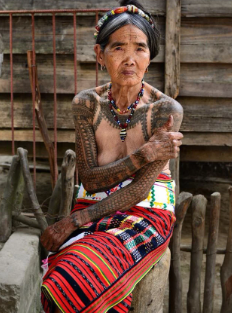Whang-od Oggay: A Living Legend

Whang-od Oggay is a 104 year old Phillipino woman who lives in Buscalan, a mountain village in the Kalinga province of the Philippines, about 15 hours from the capital of Manila, and she is single handedly keeping the tattoo tradition of the Butbut peoples alive. She is the last of the mambabatok, which is the name given to traditional Kalinga tattooists. In tradition mambabatok can only be men but that changed when Oggay’s father took her on as an apprentice when she was 15. This was a big step in tattooing in Buscalan and even now Whang-od is carrying on the tradition in her own way. It is vital to their tattooing that the tradition is passed down through family, Whang-od never had any children of her own so the apprenticeship fell to her two grandnieces. There is a rule for their tattooers that the skill has to be passed down the family bloodline. Tattoos done by someone who was not in the bloodline were bound to be infected. Whang-od teaches her niece Grace,
“you must learn to work hard and be patient and modest, because you’re doing the tattoo for someone else, not yourself.”


Left: Whang-od and her Grandniece Grace. Right: Whang-od with Grace and her other apprentice
Traditionally Butbut warriors earned their tattoos in battle. There were special chants, prayers, and fortune telling that went into the sacred tattooing process. These warriors were called headhunters, their tattoos were earned by protecting the village or by killing enemies and bringing back their heads hence the term headhunters. Headhunting has since been outlawed in the Philippines and there is no more need for warriors in the Butbut’s new found peace. Whang-od still tattoos but she no longer recites the sacred chanting of the more ceremonious warrior tattoos or does fortune telling. Since these chants are reserved for the Butbut warriors, sadly Whang-od cannot pass them along to her apprentices (as there are no more warriors) and so the ceremony of tattooing a Butbut warrior will likely be lost with Whang-od.


Above: men tattooed by Whang-od
The Butbut warriors are not the only people of their community to be tattooed, especially now since their war practices have turned to peace. For Butbut women, tattoos are beautifying. In a short video documentary of Whang-od and the Butbut another woman in the village says, “A girl gets tattooed to become a woman and attract a husband.” The documentary video is about 20 minutes long and jam-packed with the history of these tattoos, I’ll attach it at the end in case you’re interested. Some women got their first tattoos as young as 13 or 14. One woman with a bird tattoo spanning both her arms recalls that “we got tattooed to have more sex appeal, to be attractive to the men.” Her tattoo may not look much like a bird to us but in traditional mambabatok style this is what bird tattoos look like.
Despite being 104 Whang-od is still self-sufficient. She does all her own rice pounding (to separate the grain from the stalk) as well as all her own cooking. In the video documentary Whang-od tells the interviewer, her eyesight is still pristine, she will stop tattooing when she can no longer see; whether that’s next year or until she passes if her eyesight is clear she will tattoo.

To tattoo Whang-od gets thorns from a lemon tree, she uses thorns to prevent infection. Getting fresh nails to tattoo with isn’t feasible to get often since their village is so remote, causing the nail she would have to rust. By using thorns she knows that her tools are clean. Lemon tree thorns are ideal over other thorns because they are more sturdy so they can take the weight that goes into hand poking, as well as being sharp enough to get through the skin. The ink she makes is made from a water and charcoal solution with a dash of sugarcane juice. She says that the sugarcane makes it especially shiny. To stencil they use a rice stalk dipped in the ink, since all the tattoos are made up of patterns with short lines.



Left: lemon tree thorns. Top right: bamboo tool with thorn inserted tattooing. Bottom right: Some of Whang-od’s designs
There has been much debate in the Philippines about how to honor Whang-od, her skill, and her legacy of keeping Kalinga tattooing alive. Some were calling for her to be recognized as one of the National Artists of the Philippines, while others thought that the National Living Treasures Award was more fitting. She actually ended up being nominated for both, each being backed by different senators. She was also awarded the Dangal ng Haraya Award which to my understanding is a very high honor. Whang-od has many accomplishments and is very important to both Philippine culture and the tattoo world. There is much more to say and learn about Whang-od so I encourage you to check out my sources and do your own research if she interests you further!
Sources:
- https://mymodernmet.com/whang-od-tattoo-artist/
- https://en.wikipedia.org/wiki/Whang-od
- https://thevalemagazine.com/2019/08/20/whang-od-tattoo-artist-philippines/
- https://www.youtube.com/watch?v=HPJjQJ1UWn4&t=1541s
- https://www.garden.eco/do-lemon-trees-have-thorns
- https://www.flickr.com/photos/eazy360/42057993714
- https://gestalten.com/blogs/journal/the-last-kalinga-tattoo-artist
- https://www.facebook.com/palicasgrace/
- https://sgmagazine.com/things-to-do-singapore/news/singapore-ink-show-returns-june-featuring-kalinga-tattooists-first-time
- https://medium.com/@alaynepeanopongpong/pagbabatok-a-dying-art-cca9d14b8f9a
- http://www.snippetmedia.com/snippetx/?p=3558






































































